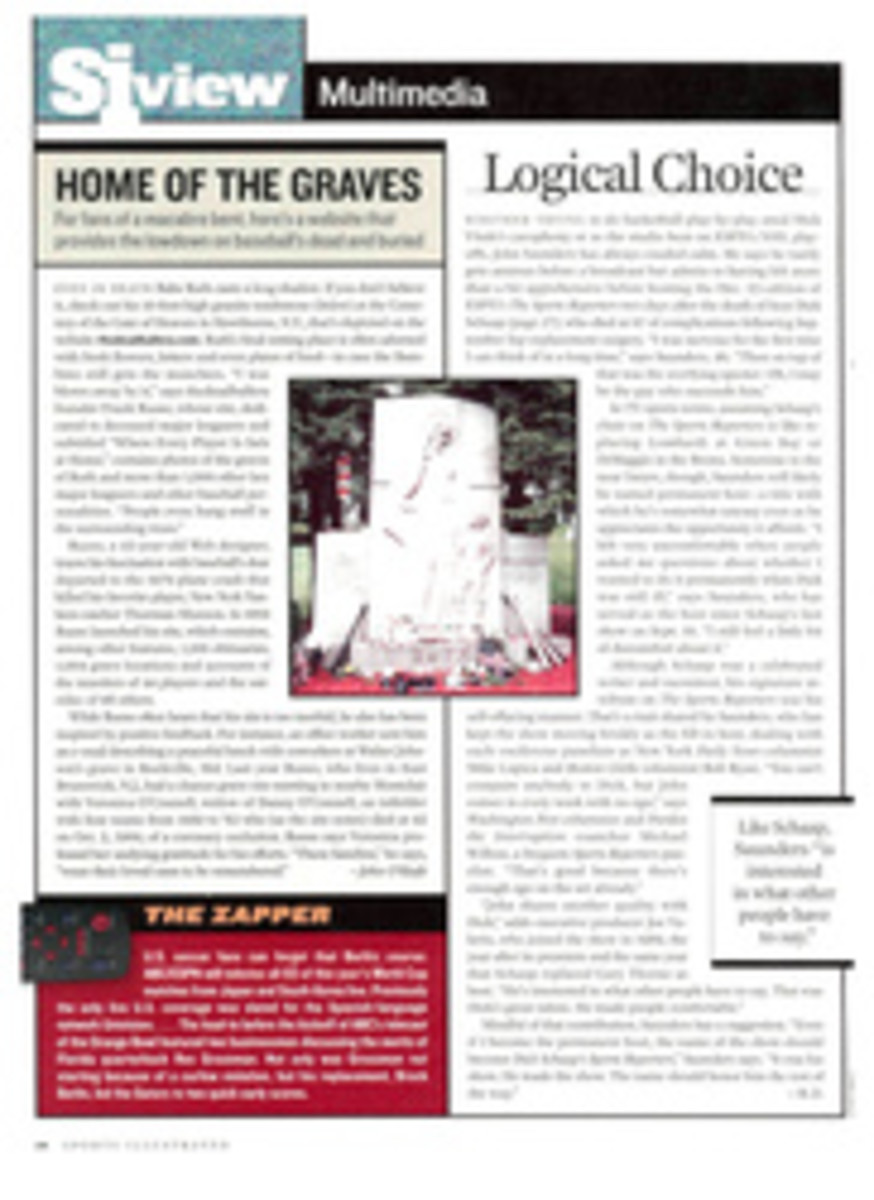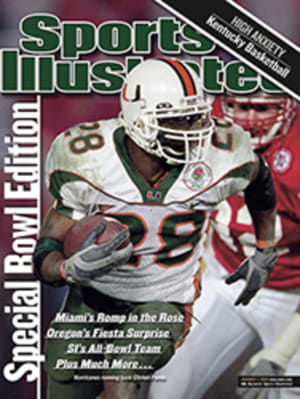
True Grit Garrison Hearst refused to call it quits despite two seasons on the sidelines with a debilitating ankle injury, and now he's back in stride and playing a key role in the 49ers' surprising run to the playoffs
Her heart was broken, but Mary Hearst had to stay strong. Her
baby was in pain, and when the tears came streaming down his
cheeks, she did what a mother does--wiped them away and assured
him that everything would be O.K. Three years ago this week her
son, Garrison, the San Francisco 49ers' star running back, was
lying on the training table in the visitors' locker room of the
Georgia Dome, his fractured left ankle throbbing, as the muffled
sounds of a shattered season resonated from above. The constant
cheers told Hearst that the Atlanta Falcons were eliminating his
team from the playoffs, ending a year in which he had set a
franchise rushing record and earned his first trip to the Pro
Bowl. What hurt most was that Hearst, having snapped his leg
while carrying the ball on the game's first play from scrimmage,
was powerless to alter his team's fortunes.
"Garrison, don't worry," said Michael Dillingham, the 49ers'
orthopedist. "I've dealt with this type of injury before. You'll
be back next year." Hearst's father, Gary, and his agent, Pat
Dye Jr., offered similarly reassuring words, but the normally
ebullient running back was devastated. He started to speak, and
Mary sensed what was coming: Why me? "No, don't say that," she
said, cutting him off in mid-sentence. "You're very fortunate.
It could have been worse. You're going to be fine."
Mother knew best, of course. Her son would indeed reclaim his
cherished role, prodding the Niners back into the playoffs with
his fearless running style and peerless running of the mouth.
All it took was 32 months of rehab, seven surgeries--including a
cutting-edge procedure that Dillingham believes had not been
attempted on a pro athlete--and unshakable faith, and Hearst is
right back where he always figured he'd be.
"I never thought I wouldn't play again," Hearst said recently at
the 49ers' training facility in Santa Clara. "One specialist I
saw a few months after the injury told me to start preparing for
life after football, and I know a lot of people around here
thought I was through. But those people didn't know what was
inside of me."
Pardon the rest of us if we didn't see this coming. Hearst, who
turned 31 on Jan. 4, has become the most inspirational player on
one of the NFL's most improbable contenders, and last Wednesday
he cemented his comeback by being selected to the Pro Bowl. His
stats through 15 games--1,149 yards on 237 carries, for a hefty
4.85-yard average--do not adequately reflect his impact. When
Hearst's ankle snapped, so did the once mighty Niners, who went
10-22 in his absence. While Hearst is not the only reason for
San Francisco's turnaround in 2001, he is certainly the
franchise's pride and joy. "I can't imagine any player meaning
as much to a team," tackle Derrick Deese says.
As the 49ers prepare for their first playoff game since that
grim day in Atlanta, Hearst's recovery stands as this season's
preeminent feel-good story. "I root for the guy, and I think
everybody in the league does," says the NFL's best running back,
Marshall Faulk, who plays for the rival St. Louis Rams. Even the
men who tackle Hearst feel warm and fuzzy about his return.
"He's one of those guys you want to hit hard and then help up
with a smile," says Miami Dolphins linebacker Zach Thomas, whose
team gave up 103 rushing yards to Hearst in a 21-0 San Francisco
win on Dec. 16. "We respect a guy who's fought his way back
after sitting out two years, and he came back better than before."
As recently as 20 months ago, Hearst faced the possibility that
he might never again walk normally. By the spring of 2000 a rare
circulatory condition called avascular necrosis had limited the
blood flow to his ankle, causing his talus bone to begin
degenerating. Dillingham says Hearst was in danger of having to
undergo surgery to fuse the bones in his ankle.
The condition, which afflicted Hearst in the aftermath of the
initial surgery to stabilize the ankle with screws and plates in
early 1999, was the same one that had forced former Raiders
All-Pro running back Bo Jackson to retire from football and to
undergo hip-replacement surgery. Hearst's second major
procedure, in July '99 by Dillingham and orthopedic surgeon Mike
Mont, involved boring holes into the dying parts of the talus,
then inserting bone plugs from a cadaver. Five months later,
however, the bone still wasn't healing, and as Hearst headed
into a second off-season of rehabilitation, Dillingham was
running out of options. He turned to Pierce Scranton, a
Seattle-based specialist who had treated conditions similar to
Hearst's by breaking the ankle near the top, cleaning out the
decaying parts and inserting plugs grafted from another part of
the patient's body. On May 6, 2000, in Seattle, Scranton and
Dillingham performed the operation that would revive a bone, a
player and a team.
The two doctors were stunned by the devastation they
encountered. Despite the previous efforts to repair it, the most
damaged parts of Hearst's talus bone, Dillingham recalls, "had
the consistency of toothpaste." During a 3 1/2-hour procedure
the surgeons removed bone and cartilage from Hearst's right knee
and used it to reconstruct the ankle. "Garrison stayed upbeat,
but sooner or later I thought he might throw in the towel,"
admits Niners coach Steve Mariucci.
Yet even with $2 million of tax-free disability insurance
waiting for him should he choose to retire, Hearst never
wavered. "I tried to drop some hints about postcareer options,"
Mary Hearst says, "but he'd say, 'Mama, I'm gonna play football.
I can't go out like this.'"
Hearst's pride may have seemed foolish to some, but it helped
persuade the 49ers to keep him around through two seasons of
inactivity. Physical therapist Lisa Giannone, who helped Hearst
rehab during the 2000 off-season, remembers him stubbornly
hobbling through agility drills at her facility while clinging
to the football he carried during the 96-yard scoring run that
had given the Niners an overtime victory over the New York Jets
in the 1998 season opener. "It wasn't logical that he'd make it
back," Giannone says, "but there was something about his spirit
that made you believe he'd find a way to play again."
The 49ers prayed he would. After four frustrating seasons with
the Phoenix and Arizona Cardinals and the Cincinnati Bengals,
Hearst, the third pick in the 1993 draft, found a comfort zone
upon signing with San Francisco in '97, running for 1,019 yards
in his first season and a franchise-best 1,570 in his second.
His rare set of skills--hitting holes without hesitation,
breaking tackles like a 5'11", 215-pound wrecking ball,
sacrificing his body to pick up blitzers and turning swing
passes into big gains--made him ideally suited for the team's
ball-control offense.
San Francisco's rushing game stayed strong with the emergence of
shifty Charlie Garner in 1999 and 2000, but without Hearst the
team was incomplete. By the 2000 season the Niners were in
rebuilding mode, and Hearst felt detached. "I got to the point
where I couldn't handle not being part of it anymore," he
recalls. "I couldn't watch football." Midway through the season
he began spending game days in the bowels of 3Com Park, pedaling
furiously on an exercise bike in an area adjacent to the team's
locker room, vaguely aware of the distant crowd noise but
oblivious to what was transpiring on the field.
Finally, after undergoing arthroscopic surgery last January on
his fibula and tibia, Hearst began to resemble his old self.
Garner had signed a free-agent deal with the Raiders, leaving
Hearst to compete for the starting job with rookie Kevan Barlow,
San Francisco's third-round draft choice. Hearst held up through
training camp and appeared to have won the position, but one
obstacle remained. A week before the start of the season,
Mariucci delivered sobering news from the front office: Hearst
would risk being released if he didn't restructure his contract.
Hearst was crushed. Hadn't he made his deal more cap-friendly a
few months earlier? Hadn't he earned his spot? "Mooch, tell me
one thing," Hearst demanded. "Do you think I can help this team
win?"
"Yes," Mariucci replied.
"That's all I want to know," Hearst said. He gave the team what
it wanted, trading easily reachable incentives, such as gaining
a single rushing yard or playing 1% of the team's snaps, for
tougher standards. In exchange Hearst got the Niners to increase
his potential take, and it appears his gamble will pay off. Dye
says Hearst, who could have made no more than $1.8 million under
the previous arrangement, now is likely to earn more than $2
million.
Getting back on the field was one thing; regaining his form was
another. In the season opener, against the Falcons at 3Com, his
11-yard run in overtime set up the Niners' game-winning field
goal. Beginning with a 17-carry, 145-yard effort in a 28-27
victory over the New Orleans Saints on Nov. 11, Hearst had four
100-yard rushing games in a six-week span. Yet 49ers running
backs coach Tom Rathman thinks Hearst's best play of 2001 may
have come in pass protection during the victory over the
Dolphins. Pinned deep in their own territory while holding a
14-0 lead in the third quarter, the Niners embarked on a
touchdown drive after quarterback Jeff Garcia's 28-yard
completion to wideout Terrell Owens--a play made possible by
Hearst's handling of a pair of pass rushers. Says Rathman, "He
bluffed the 'backer [Morlon Greenwood] and forced him outside,
then came off late and knocked the strong safety [Brian Walker]
off his feet."
With his snappy wit and endless supply of playful critiques,
Hearst has long been a favorite in the locker room. Since his
return, though, his every move carries considerable weight.
Before and after practice each day the team's training staff
subjects Hearst to ankle-manipulation exercises and soft-tissue
massages, none of which goes unnoticed. "G is probably the most
popular person in this locker room," guard Ray Brown says. "He
galvanizes this team. When we see what he puts his body through
just to practice, our aches and pains don't seem so significant."
Now he's one glorified G. In late December the San Francisco
players voted Hearst the recipient of the Len Eshmont Award for
courageous and inspirational play. Another honor is on the way:
the NFL's Comeback Player of the Year. But Hearst is most
excited about his first trip to the Pro Bowl. Three years ago
his parents and other family members from Lincolnton, Ga., had
already purchased airline tickets to Honolulu when he broke his
ankle, and returning them was particularly painful for one
jilted traveler. "Ever since I can remember, it's been my dream
to go to Hawaii," Mary Hearst says. "Before this season, when
Jerry Rice invited him there for a function, Garrison asked me
if I wanted to go with him. I told him, 'No, I'm going to wait
until you start playing, and maybe you'll make the Pro Bowl
again."
Garrison's incredulous reply: "Maybe?"
"I didn't think it would happen," Mary admits. "I know he's
tough, and I know he's got a lot of faith in himself. But what
he's doing is truly amazing, even to me."
COLOR PHOTO: PHOTOGRAPHS BY PETER READ MILLER NO DAY AT THE BEACH To help strengthen his legs, Hearst runs through drills in a sand pit at the 49ers' Santa Clara practice facility.
COLOR PHOTO: PHOTOGRAPHS BY PETER READ MILLER GOOD AS GOLD Hearst is averaging almost as many yards per carry as he did during his record-breaking season in 1998.
Doctors were stunned by the devastation. Parts of Hearst's bone
"had the consistency of toothpaste."

